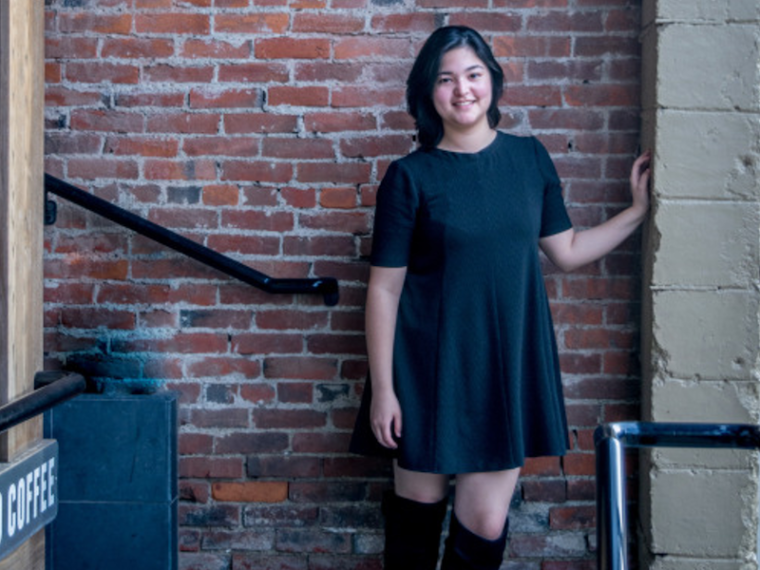Discovering New Sound Worlds with Katherine Lerner Lee ’19
January 18, 2017
Conservatory Communications Staff

Oberlin’s Contemporary Music Ensemble (CME) is perhaps best known for its riveting interpretations of new instrumental works. This February, the ensemble presents a vocal-centric program that includes two large works: Sir Harrison Birtwistle’s Entr'actes and Sappho Fragments, featuring third-year soprano Katherine Lerner Lee, and Oberlin professor Stephen Hartke’s Tituli, featuring guest countertenor Joseph Schlesinger and conservatory voice majors Nicholas Music, Matthew Straw, Jedidiah Rellihan, and Joseph Klinger. Oberlin Assistant Professor of Conducting Gregory Ristow ’01 will conduct the ensemble in a performance at Oberlin’s Warner Concert Hall on Friday, February 24, at 8 p.m., followed by an off-campus presentation on Sunday, February 26, at 2 p.m. at the Cleveland Museum of Art.
A skillful sight reader and proficient pianist, Katherine Lerner Lee was thrilled when the opportunity arose to dive into the unfamiliar sound world of Birtwistle’s music alongside CME and conductor Ristow.
“When you look at the score, it is quickly apparent that each musical line has its own gestures," she says. "But the more and more I listen to the piece and hear it with the ensemble, I am amazed at how perfectly everything fits together…you get these waves of sounds that are so evocative and descriptive.”
Even a musician with an ear for contemporary music and an inclination toward sight reading must find a way to muddle through and ultimately master atonal works. “I’ve done several performances of new works by student composers here at Oberlin, mostly smaller song cycles, and it’s been super fun. But I’ve never attempted to learn a piece quite as challenging as this one,” she says enthusiastically.
With a sigh of relief and a bit of satisfaction, Lee recounts the process that helped her successfully learn the five canti she will be performing with the ensemble. “It was a lot of repetition. I approached the learning process in two phases: I learned the rhythms and then the sequence of pitches, which I then combined and repeated until what resulted was a sort of melody. Once I had memorized my line, I began to look at the score to find the notes and motifs that would help me get my pitch: What is the figure? What is the predominant melody that can be a landmark? Once I internalized all of that, I began to find my place in the context of the instrumental lines.”
“This opportunity has taught me a lot of resilience…the more you practice, the more your body is in tune with the music. And while putting the piece together with the instrumentalists has been a bit nerve-racking, there are many aspects of the piece that have gotten easier, thanks to their certain musical motifs that inform my singing.”
“My teacher, Professor Lorraine Manz, has been very supportive of this endeavor, and we both agree that this experience has been helpful to me technically. There are so many jumps and gestures that the singer must be committed to and in good voice for. Singing this piece isn’t so different from the experience of singing an opera aria, except that I have a bit more liberty with the sound. There are interesting combinations of vowel sounds and registration that are not the most naturally resonant in the singing voice, but I’ve learned to trust that the composer knew what he was doing and intended a particular sound. It is quite liberating!”
For more information about the Contemporary Music Ensemble’s upcoming performance in Oberlin, visit Oberlin's online events calendar.
Tags:
You may also like…
Contemporary Collaborations with Third Coast Percussion
April 15, 2025
“Strum,” “Strike,” and “Bend” are all evocative references to the physicality of string and percussion instruments. And one is especially significant.
Martha Redbone Hears Her Musical Call
March 18, 2025
The vocalist and songwriter brings her distinct blend of folk, blues, gospel, and more to Finney Chapel on April 6 in an appearance with the Martha Redbone Roots Project.
Oberlin Opera Brings “Jack and the Beanstalk” to Schools Across Northeast Ohio for Winter Term
March 10, 2025
“It was really amazing going into the community and performing an art form that they probably haven't seen before,” second-year voice major Ella Vaugn said, “Teachers would tell us that they've never seen their students so engaged.”


